The history of a paradox of electrical engineering
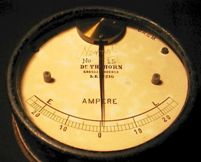 If you compose an electric circuit from a current source, an energy consumer and the wires connecting them, close it, then an electric current will flow along this circuit. It is reasonable to ask: “And in what direction?” The textbook on the theoretical foundations of electrical engineering gives the answer: "In the external circuit, the current flows from the plus of the energy source to the minus, and in the inside of the source from the minus to the plus."
If you compose an electric circuit from a current source, an energy consumer and the wires connecting them, close it, then an electric current will flow along this circuit. It is reasonable to ask: “And in what direction?” The textbook on the theoretical foundations of electrical engineering gives the answer: "In the external circuit, the current flows from the plus of the energy source to the minus, and in the inside of the source from the minus to the plus."
Is it so? Recall that an electric current is the ordered movement of electrically charged particles. Those in metal conductors are negatively charged particles - electrons. But the electrons in the external circuit move just the opposite from the minus of the source to the plus. This can be proved very simply. It is enough to put an electronic lamp - a diode in the above circuit. If the anode of the lamp is positively charged, then the current in the circuit will be, if negative, then there will be no current. Recall that opposite charges attract, and like charges repel. Therefore, the positive anode attracts negative electrons, but not vice versa. We conclude that for the direction of electric current in the science of electrical engineering, they take the direction opposite to the motion of electrons.
The choice of the direction opposite to the existing one cannot be called otherwise paradoxical, but the reasons for such a discrepancy can be explained if we trace the history of the development of electrical engineering as a science.
Among the many theories, sometimes even anecdotal, trying to explain the electrical phenomena that appeared at the dawn of the science of electricity, let us dwell on two main ...
Why do I need an oscilloscope?
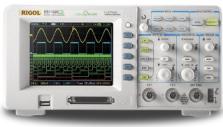 Sooner or later, any novice electronics engineer, if he does not give up his experiments, will grow to circuits where you need to monitor not just currents and voltages, but the operation of the circuit in dynamics. This is especially often needed in various generators and pulse devices. There is nothing to do without an oscilloscope!
Sooner or later, any novice electronics engineer, if he does not give up his experiments, will grow to circuits where you need to monitor not just currents and voltages, but the operation of the circuit in dynamics. This is especially often needed in various generators and pulse devices. There is nothing to do without an oscilloscope!
Scary device, huh? A bunch of pens, some buttons, and even the screen and nifiga is not clear what is here and why. Nothing, we’ll fix it now. Now I’ll tell you how to use the oscilloscope.
In fact, everything is simple here - the oscilloscope, roughly speaking, is just ... voltmeter! Only cunning, able to show a change in the shape of the measured voltage ...
What tool should an electrician have, except for pliers and a set of screwdrivers
 Typically, an electrician going to a customer’s call takes a suitcase or a handbag full of various pieces of iron, screws and dowels, as well as an electrician’s tool in his handbag - the glands with which the electrician performs certain tasks. What tool should he be an electrician?
Typically, an electrician going to a customer’s call takes a suitcase or a handbag full of various pieces of iron, screws and dowels, as well as an electrician’s tool in his handbag - the glands with which the electrician performs certain tasks. What tool should he be an electrician?
Rule of an isolated tool. The most basic association of an electrician with pliers. Pliers (pliers) must be with insulated handles. The insulation material for the pens can be either plastic or rubber. The main thing is that the insulation of the handles can withstand a voltage of 1000 volts. In practice, it’s convenient to have a pair of pliers with you — some medium or small, others large.
As well as pliers, screwdrivers will always come in handy ...
What do we take on a hike?
Packing an electrician's suitcase is very similar to picking a backpack on a camping trip. It is necessary to foresee all the little things and take as many tools as possible so as not to get into the prosak on a call from the client. However, here, just as in a hiking trip, it is important not to overdo it, otherwise you can simply not bring a suitcase. So, what else does the electrician have in his bag, except for pliers and a set of screwdrivers? ...
About grounding and grounding for "dummies"
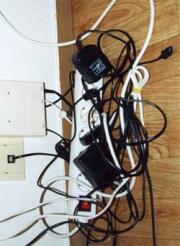 My bitter experience as an electrician allows me to say: If you have the "grounding" done as it should - that is, the shield has a connection point for the "grounding" conductors, and all the plugs and sockets have "grounding" contacts - I envy you, and there’s nothing for you worry.
My bitter experience as an electrician allows me to say: If you have the "grounding" done as it should - that is, the shield has a connection point for the "grounding" conductors, and all the plugs and sockets have "grounding" contacts - I envy you, and there’s nothing for you worry.
Grounding Rules
What is the problem, why can not you connect the ground wire to the heating or water pipes?
Actually, in urban conditions, stray currents and other interfering factors are so great that anything can appear on the heating battery.However, the main problem is that the trip current of the circuit breakers is quite large. Accordingly, one of the options for a possible accident is a breakdown of a phase to a case with a leakage current just somewhere on the boundary of the operation of the machine, that is, in the best case, 16 amperes. Total, we divide 220v by 16A - we get 15 ohms. Just some thirty meters of pipes, and get 15 ohms. And the current flowed somewhere, in the direction of not sawn wood. But that is no longer important. The important thing is that in the neighboring apartment (up to which 3 meters, and not 30, the voltage on the tap is almost the same 220.), but on, say, the sewer pipe - a real zero, or so.
And now the question is - what will happen to the neighbor if he, sitting in the bathroom (connected to the sewer by opening the cork), touches the tap? Guessed?
The prize is prison. According to the article on violation of electrical safety rules that caused the victim.
Do not forget that you can not do an imitation of the "grounding" circuit, connecting the "zero working" and "zero protective" conductors in the Euro socket, as some "craftsmen" sometimes practice. Such a replacement is extremely dangerous. Cases of burning off the “working zero” in the shield are not rare. Thereafter ...
How to make a welding machine from an electric motor
 The idea of producing transformers from electric motor stators was practiced twenty years ago and was popular among home-made ones. By the way, the income brought tangible. For 50-75 Soviet carbovanets, such a product could be disposed of in one to two days. What I did. There have even been publications on this subject in The Modeler-Designer and The Inventor and Rationalizer.
The idea of producing transformers from electric motor stators was practiced twenty years ago and was popular among home-made ones. By the way, the income brought tangible. For 50-75 Soviet carbovanets, such a product could be disposed of in one to two days. What I did. There have even been publications on this subject in The Modeler-Designer and The Inventor and Rationalizer.
A little later there were also publications about welding transformers from LATRs. And if there were no special problems with transformers from LATRs, then with those from engines, the results for self-made ones were very far from the calculated ones. And the reason for this is a lack of knowledge in electrical engineering, and magazines published material hiding all underwater currents.
It was more like an instruction to a young dushman, with landmine recipes. All that was left was to shout: “Allahu akbar” or “Banzai” and plug into the outlet. And then, at least, burnt traffic jams, as a maximum - a cord to the electricity meter and a lot of flattering reviews for the inventors and their parents.
Of course, I understood all the reasons for the failures, but I did not want to give out secrets, so as not to breed competitors. And only after I found myself a more interesting income, in the form of electric rods, I began to share information. I then still lived in Samara and the opportunity to earn money on fish attracted me much more than groan and sweat over the welders.
So, about transformers. First you need to choose the right motor ...
 Some models of bells or bells have batteries inside the case, others have built-in transformers that reduce the mains voltage of 220 V (or 230 V) to small values necessary for this type of electrical appliance. In many models, both power methods can be used. Most of them use two or four batteries with a voltage of 1.5 V, and some use one battery with a voltage of 4.5 V.
Some models of bells or bells have batteries inside the case, others have built-in transformers that reduce the mains voltage of 220 V (or 230 V) to small values necessary for this type of electrical appliance. In many models, both power methods can be used. Most of them use two or four batteries with a voltage of 1.5 V, and some use one battery with a voltage of 4.5 V.
Commercially available transformers for doorbell circuitry typically have three pairs of 3, 5, and 8 V pins (contacts) that can be used in various types of bells. As a rule, 3 and 5 V are used in calls and buzzer, and 8 V is suitable for many variants of bells.
However, some bell models require a higher voltage, and they need transformers with outputs of 4, 8 and 12 V. The bell transformer must be designed so that the mains voltage cannot reach the low voltage windings.
Batteries, buttons and bells are connected by a two-core insulated “bell wire”. This thin wire is usually laid on the surface and fastened with small piercing brackets.The bell wire also connects the bell and button to a transformer.
Connect the double-insulated bell transformer to the junction box or ceiling socket of the lighting circuit with a rigid wire with two ...
Mysteries of Crossed Currents - Hall Effect
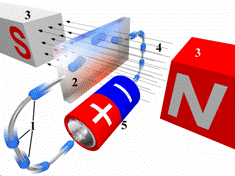 At the end of the last century, a young American physics student Edwin Hall made a discovery that entered his name in physics textbooks. He conducted a simple, “student” experiment — he studied the propagation of current in a thin metal plate placed between the poles of a strong electromagnet. Students of all universities undergo laboratory practice, where they are taught with simple examples the skill of the experiment. So it was this time. A humble student could not have imagined that his simple experience would give rise to an avalanche of research, some of which will be marked by the most honorable scientific award - the Nobel Prize.
At the end of the last century, a young American physics student Edwin Hall made a discovery that entered his name in physics textbooks. He conducted a simple, “student” experiment — he studied the propagation of current in a thin metal plate placed between the poles of a strong electromagnet. Students of all universities undergo laboratory practice, where they are taught with simple examples the skill of the experiment. So it was this time. A humble student could not have imagined that his simple experience would give rise to an avalanche of research, some of which will be marked by the most honorable scientific award - the Nobel Prize.
The device with which Hall worked consisted of two crosswise arranged electrical circuits - this is how they tie a box of sweets with a ribbon. The chains differed in that one of them contained an electric battery and the current from it passed along the plate, the other, transverse, had no current sources and simply connected the edges of the plate.
As expected, in the case when the electromagnet was turned off, the instruments recorded the current flow only along the plate — in the circuit with the battery — and its absence in the “empty” transverse circuit. No wonder. However, as soon as the electromagnet turned on, an electric current in itself appeared in the transverse circuit, as if from nothing. It was interesting, but there was no miracle here - an explanation was found quite quickly ...
The most interesting thing about trains on a magnetic suspension
 Magnetoplan or Maglev (from English magnetic levitation) is a train on a magnetic suspension, driven and controlled by magnetic forces. Such a composition, unlike traditional trains, does not touch the rail surface during movement. Since there is a gap between the train and the surface of movement, friction is eliminated, and the only drag force is the force of aerodynamic drag.
Magnetoplan or Maglev (from English magnetic levitation) is a train on a magnetic suspension, driven and controlled by magnetic forces. Such a composition, unlike traditional trains, does not touch the rail surface during movement. Since there is a gap between the train and the surface of movement, friction is eliminated, and the only drag force is the force of aerodynamic drag.
The speed achievable by the Muggle is comparable to the speed of the aircraft and allows you to compete with air traffic at small (for aviation) distances (up to 1000 km). Although the idea of such a transport is not new, economic and technical limitations did not allow it to unfold fully: for public use, the technology was implemented only a few times. Currently, Maglev cannot use the existing transport infrastructure, although there are projects with the location of the elements of the magnetic road between the rails of a conventional railway or under the track.
At the moment, there are 3 main technologies for magnetic suspension of trains:
1. On superconducting magnets (electrodynamic suspension, EDS) ...
Which is better - do the electrical installation yourself or call professional electricians?
 In bookstores and in ruins, a huge number of books and brochures with titles such as “Wiring in 5 minutes”, “To Yourself an Electrician”, “100 Tips for a Home Master - Installation of Wiring” and other similar publications. Looking at this “splendor”, you might think that wiring is a very simple task that you can really learn in five minutes. But this is not so.
In bookstores and in ruins, a huge number of books and brochures with titles such as “Wiring in 5 minutes”, “To Yourself an Electrician”, “100 Tips for a Home Master - Installation of Wiring” and other similar publications. Looking at this “splendor”, you might think that wiring is a very simple task that you can really learn in five minutes. But this is not so.
This will be confirmed to you by any professional for whom the installation of sockets, automatic machines, electrical panels, etc. this is not a “hobby”, as the authors of books represent reality, but a profession. Not only does wiring require a mass of specific knowledge and skills, it also requires compliance with safety regulations. For this reason, following some of the tips from the compilers of Home Master collections is simply dangerous.
Any work with electric current is classified as dangerous to human life if the voltage in the line is more than a hundred volts. Therefore, it is quite natural that only persons who have received special instruction and training and possess debugged skills in both electrical installation and first aid in case of electric shock are allowed to do such work. If we say the “letter of the law”, then only people with a third qualification group for electrical safety meet these requirements.
And what can lie in wait for a layman? ...
 Despite the centuries-old study of the history of Egypt for modern man, the secrets of ancient civilization and its knowledge remain unsolved.
Despite the centuries-old study of the history of Egypt for modern man, the secrets of ancient civilization and its knowledge remain unsolved. Exploring the heritage of ancient Egypt in drawings of temples, tombs, on stone slabs, in texts, etc., you can see the mysterious technical devices that they owned, information about which was transmitted to descendants.
Among them are: lamps, sources of static energy, as well as mechanisms that use this energy to perform labor-intensive work.
All material bodies have electrostatic radiation of different strengths. The most powerful of them were used by ancient civilizations.
Biefeld-Brown effect and other electromagneto-gravitational effects
 Mankind has repeatedly encountered natural phenomena and experiments that cannot be explained from the standpoint of modern science (in any case, from the standpoint of an accessible part of it). These include the existence of anomalous points on the planet, anti-gravity effects, transitions to other dimensions of people and objects, etc. These phenomena, as a rule, occur in the presence of electric and magnetic fields, demonstrate the relationship of gravitational space-time with electromagnetic fields.
Mankind has repeatedly encountered natural phenomena and experiments that cannot be explained from the standpoint of modern science (in any case, from the standpoint of an accessible part of it). These include the existence of anomalous points on the planet, anti-gravity effects, transitions to other dimensions of people and objects, etc. These phenomena, as a rule, occur in the presence of electric and magnetic fields, demonstrate the relationship of gravitational space-time with electromagnetic fields.
Each elementary particle of matter carries not only gravitational, but also an electric charge, however, in general, the electric potential in our space is equal to zero. The lack of electric potential in the gravitational field-ether is due to two factors:
1. Equality of the ether-forming pair of particles in our space (proton and electron) of electric charges of a positive and negative sign.
2. The number of protons and electrons is exactly equal in the entire closed volume of the metagalaxy.
These factors are a property of matter, a property of the ether field of the constant gravitational potential of the closed space-time of our metagalaxy. An electric field can be present only in local regions of space-time. From the point of view of a unified theory of field, space and time, radiation crossing a similar region acquires two components: electromagnetic and magnetogravitational. In the space region of double electrogravity nature, not only a change in the electric, but also a change in the gravitational field leads to the formation of a magnetic field. The amplitude of the electromagnetic and magnetogravitational component of single oscillations depends on the potential of the field of the opposite nature (gravitational and electric, respectively).
A change in the magnetic field in space-time of a double nature forms both an electric and a gravitational field, depending on the potential of the field of the opposite nature. If the electric potential is equal to zero, then the energy of the magnetic field completely transfers to the electric field. In an ideal gravitational ether, there are only electromagnetic waves.In the presence of an electric potential of a positive or negative sign, part of the magnetic energy is spent on the formation of a gravitational alternating field, and the larger the magnitude of the electric potential, the greater the amplitude of the gravitational component of the single electromagnetic-gravitational vibrations.
The gravitational ether of our space is an inexhaustible source of electromagnetic energy. Currently, devices have already been created that receive electricity "from nothing": from space-time of a gravitational nature. Such devices lay the foundation for the energy of the future ...
Tips of an experienced electrician - replacing and installing electrical wiring in an apartment
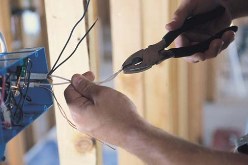
In this article we will analyze in detail all the subtleties of the process of the device in the apartment of the new wiring. This work can be successfully carried out independently. But, before starting work, it is very advisable to start objectively assessing your real capabilities, since installing electrical wiring in an apartment is a complex process and certain knowledge and skills are necessary for its successful implementation.
Cable brand selection
1. Each core of the wire must be rigid (single core), because all sockets and switch are designed for installation with a hard wire.
2. The choice of brand of occasion. Three types of wire are mainly used: NYM, VVG, PUNP.
NYM cable is a cable with copper single-wire conductors with reliable triple insulation.
The first layer is PVC, the second layer is a rubber sheath, the third is each copper core in PVC. But this wire is not without flaws. It is not recommended to be placed in raw concrete and carried out outdoors, it has a large diameter and is quite expensive.
But, if you do wiring in the apartment and want something more reliable, then take, of course NYM.
VVG cable - cable with copper single-core conductive conductors, with insulation from PVC compound - value for money. It has double insulation: common PVC and each core in PVC. VVG can be laid anywhere: both on the street and in concrete. Isolation is slightly worse than NYM, but better than PUNP. If you do not need extra expenses, we select the simplest and most commonly used PUNP wire ...
